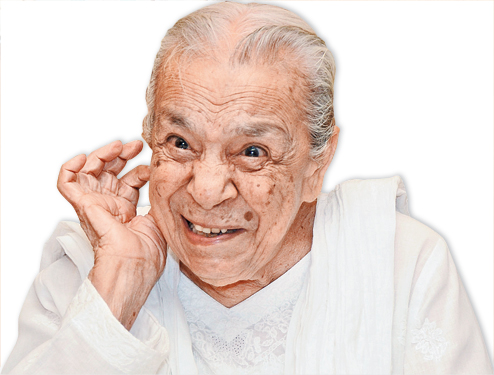 |
Sounak Chacraverti, a Calcutta-based independent curator and editor, could not interview Zohra Sehgal face to face as she had to leave for a shoot when he reached. But true to her word, she later mailed him five hand-written sheets with responses to his queries. With the passing of Zohra on July 10, the dream meeting will remain a dream.
Chacraverti shares excerpts from Zohra’s reminiscences of her younger days, especially of two women from Bengal — Sati Ghosh, Satyajit Ray’s sister-in-law, and Ruma Guha Thakurta.
Zohra on Prithvi Theatre
I joined Prithvi Theatre in October 1945, after its inception in January 1944. Before that, I was running my own dance school, The Zoresh Dance Institute, in Lahore, together with my husband Kameshwar Sehgal. Theatre was my first love, although I had been performing as a dancer with Uday Shankar for the past nine years, touring the world as his partner and as a teacher at his dance centre in Almora. Hence when I saw the Prithvi Theatre plays, I immediately shifted my career to acting.
I had the experience of a professional performer as far as movement and emotional expression were concerned, but I completely lacked any knowledge of folk production, which gradually became a part of my work through the 14 years I spent at Prithvi Theatre. My original performances were drastically stylised. And it was only later that I swam into the current of naturalistic acting by watching Prithviraj Kapoor, our “Papaji”. Papaji was a brilliant actor, giving stellar interpretations to every lead in each new play. In my vast travels from San Francisco to Kuala Lumpur and from the North Cape to Java-Bali, I have yet to find an actor of his calibre on stage. On screen I had my reservations on his interpretations, apart from Sikander and Awara. I found both these film roles great.
As a person, what can I say! If there was ever a devata purush in this world, Prithviraj was one. He had no personal pride in his looks, status or talent. With the rest of his troupe, he travelled in third-class compartments and slept on the floor like all of us did during the tours. This knocked out all my previous snobbery of belonging to the upper echelons of society.
Zohra on her peers
Of course, there was Papaji himself in a class of his own. Then came other members of the Theatre such as Uzra Butt, my sister and Papaji’s leading lady for 16 years, as well as Indumati Lele, Shaukat Azmi and Sati Devi. Among the male members were Sajjan, Prem Nath and the three Kapoor brothers — Raj, Shammi and Shashi. Then there were the IPTA artistes — Balraj and Damayanti Sahni, Dina Gandhi [became Pathak later], Uma Anand [film director Chetan Anand’s wife], Ramesh Thapar and Hema Kesarcodi.
I met Sati Devi Ghosh (Didi to all Theatre members) on joining Prithvi Theatre in 1945. Didi was one of the first singers and actors to join Prithvi Theatre at its inception and one of the few artistes left at its closure in 1960-61. To me, she became a true friend, generous to a fault, an excellent cook and, for the younger actors, an adviser on all moral issues.
During the tours, Didi would steal down to the common kitchen and prepare delicious tidbits for my children, Kiran and Pavan, who were always with us during their holidays from Bombay. Whenever Didi went to Calcutta, she would bring back smoked cheese from New Market for Uzra and me. Sati Devi had a fabulous collection of Bengali cotton saris and was always very particular about her appearance. In the stage plays, she looked authentic in whichever costume was required for the different roles, as an ashramite in Shakuntala, a Pathani retainer in Pathan or a domestic help from Uttar Pradesh in Gaddar.
As a selected friend, I attended two (almost secret) weddings at her flat in Bandra, one was Ruma’s wedding to Kishore Kumar and the other Satididi’s sister Monku’s [Bijoya] wedding to Satyajit Ray.
Didi was very outspoken and emphatic in her comments. I remember her remarking, “Zohra is a witch; in spite of (being) plain-looking, she manages to look beautiful at times.” Didi was a bit awed by my arrogant behavior but she just adored my sister Uzra for her sweet and elegant nature. However, one could always depend on Didi.
Ruma joined Prithvi Theatre as a young actor together with her mother. She started appearing in the crowd scenes with other members and was a keen and talented dancer. Over the years, I saw her grow up from a cherubic child to a stunning beauty. She had her mother’s lovely singing voice and large expressive eyes. Added to these inherited gifts were a gorgeous figure and a classical set of features. Her speech and behaviour were gentle and there was always a smile on her lips.
Chetan Anand’s Neecha Nagar (1946) was my first film as an actor and dance director in which I had choreographed a number with Ruma and her cousin Gopa. Ruma was also a dancer in Chetan Anand’s next film Afsar [with Dev Anand and Suraiya], which was a Navketan production. Later in the Fifties, my husband Kameshwar and I started a dance troupe called Sehgal Ballet in which we incorporated the younger actresses from Prithvi Theatre as well as Ruma and Gopa. Our performances were held when we were not actively engaged in a Prithvi Theatre show.
After leaving Bombay, Ruma came back from Calcutta to perform as a singer in a choir in which all the girls wore white saris with orange borders. This repertoire was directed and conducted by Salil Chowdhury.
This interview, hitherto unpublished, was taken in October, 2007

